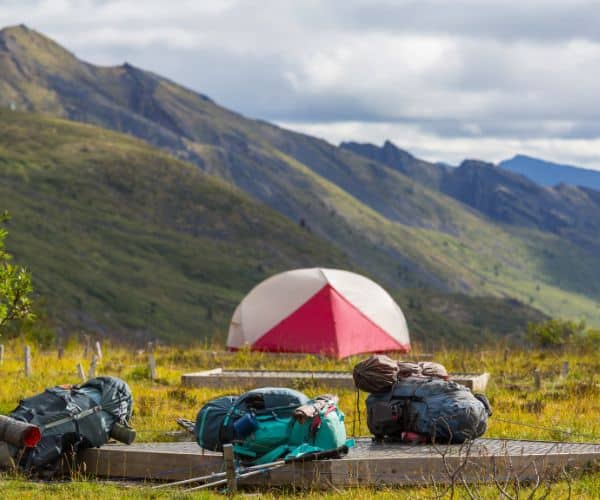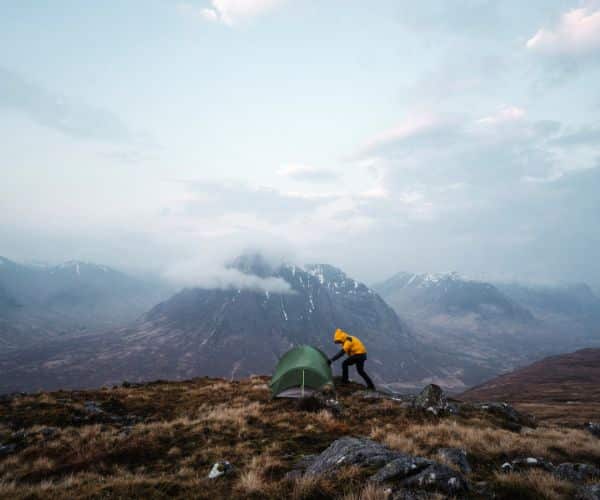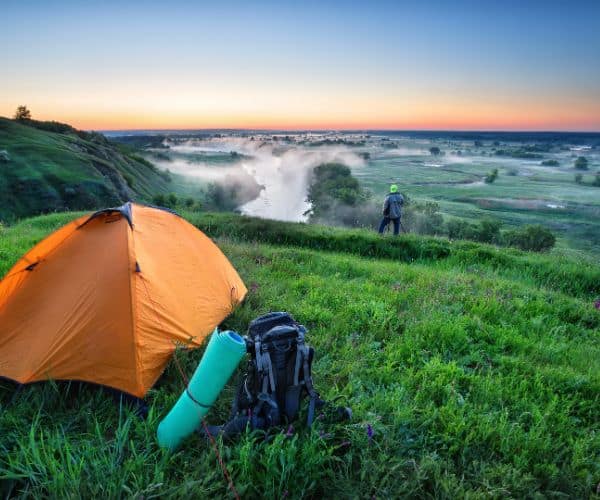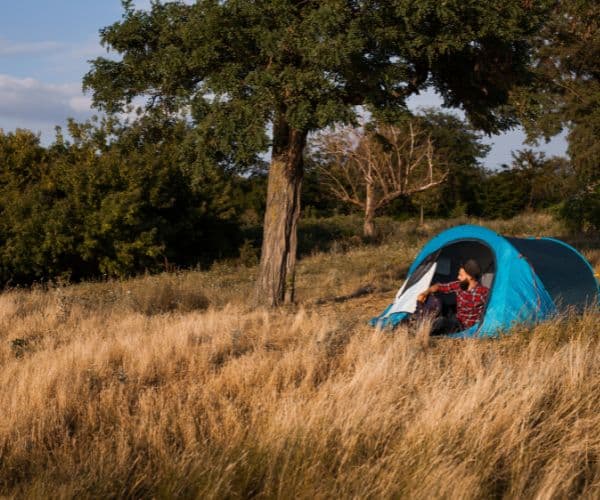There’s something undeniably magical about waking up to the sounds of birdsong and wind through the trees, far from crowded campsites, traffic noise, and the hustle of everyday life. Increasingly, people across the UK are swapping traditional holidays and busy caravan parks for the freedom of wild camping. Whether it’s pitching a tent on a remote hillside, parking up a campervan overlooking the sea, or sleeping beneath the stars in a forest glade, wild camping offers an unparalleled sense of escape.
According to a report by the Camping and Caravanning Club, interest in off-grid camping has surged since the COVID-19 pandemic, with a marked increase in people searching for “wild camping” online and a sharp rise in camping gear sales. Google Trends shows UK searches for “wild camping” have increased steadily year-on-year since 2020.
This movement isn’t just about saving money (though avoiding high accommodation costs certainly helps). It’s being driven by a deeper desire for solitude, simplicity, and reconnection. For many, wild camping is the ultimate digital detox – a chance to escape the screens, the noise, and the packed itineraries of modern life. It offers flexibility, spontaneity, and a return to the basics, which is increasingly attractive in our over-scheduled world.
And yet, while the call of the wild is tempting, it comes with responsibilities. Freedom and flexibility are the appeal, but it pays to know the rules. There are still legalities and environmental considerations to keep in mind. Nobody likes admin, but a few minutes of research before you go can help you avoid a hefty fine or a frustrated landowner.
Does a wilderness adventure take your fancy? We’ll explore the ins and outs of wild camping in the UK and Europe, including where you can legally pitch up, what makes a good spot, and how to be a responsible wild camper.
Why wild camping is gaining popularity
Wild camping appeals to a wide range of people. Outdoor enthusiasts, hikers, solo travellers, budget adventurers and even families looking for something different are all embracing the freedom it offers.
It’s a chance to disconnect from screens and reconnect with nature. You don’t need a reservation or a packed itinerary – just a rucksack, some basic gear, and a spirit of adventure. It’s also a low-cost alternative to hotels and holiday parks, and ideal for those wanting to tread lightly on the planet.
And let’s not forget the Instagram-worthy views. Social media has definitely played a role in popularising wild camping, with dreamy photos of tents at sunrise inspiring others to give it a try.
Where can you wild camp in the UK?

This is where things get a bit complicated. Unlike some European countries, wild camping in the UK isn’t universally legal. The legality and availability of wild camping opportunities depend heavily on location, and understanding the rules is essential before heading out.
Scotland
Thanks to the Land Reform (Scotland) Act 2003, wild camping is legal and widely accepted. Campers are allowed to pitch up on most unenclosed land, as long as it’s done responsibly and within the guidelines of the Scottish Outdoor Access Code. Avoid enclosed fields, private gardens, and areas near dwellings, and always leave no trace.
England, Wales & Northern Ireland
In these parts of the UK, wild camping is technically illegal without the express permission of the landowner. This applies to all land, whether public or private, and includes national parks, beaches, forests, and farmland. Wild camping without permission is classed as trespassing, and although it’s a civil rather than criminal offence, landowners do have the right to ask you to leave. In some cases, especially on protected land, you could face fines or be reported to the local authority.
That said, wild camping is often tolerated in remote upland areas such as parts of the Lake District, Snowdonia, and the Peak District, especially if campers are discreet, leave no trace, and camp only for a single night. However, this tolerance is informal and cannot be relied on.
Dartmoor
This National Park was once the only place in England where wild camping was legally permitted without seeking permission. However, a recent court ruling altered that. Now, wild camping is only allowed in specific areas under an agreement with landowners, and a map of permitted zones is available online. Always check the most up-to-date guidance before you go.
It’s also worth noting that in all areas, bivouacking (sleeping in a bag or under a tarp without a tent) may sometimes be more accepted, though the same legal framework still applies. Additionally, if you do seek permission and treat landowners with respect, many are open to responsible campers staying overnight.
Ultimately, the key to successful wild camping in the UK is discretion, preparation, and respect. Always research your chosen area, know your rights, and be ready to move on if challenged.
Best places to wild camp in the UK

Due to restrictions Scotland is where you’ll find the best spots for wild camping, you’re permitted to camp across most unenclosed land, making it the top destination in the UK for wild campers. With its diverse landscapes, from highland peaks to coastal stretches, Scotland offers a range of stunning and legal places to pitch up. Here are a few standout locations:
Cairngorms National Park
This vast, remote region is a dream for adventurous campers. Expect dramatic mountain backdrops, ancient Caledonian pine forests, and mirror-like lochs. The terrain offers seclusion in abundance, and the clear air and dark skies are perfect for stargazing. Just be prepared for changing weather and bring proper gear.
Loch Lomond & The Trossachs National Park
While parts of this park fall under a seasonal Camping Management Zone (March to September), there are designated permit areas where wild camping is still allowed. Outside of the zones, responsible camping is welcomed. Lochside spots offer incredible views, and the area is popular with walkers, paddlers, and cyclists.
Isle of Arran
Often referred to as “Scotland in miniature,” Arran has everything from beaches and moorland to mountain peaks. It’s accessible by ferry but still feels remote. Wild camping is generally welcomed in upland and coastal areas, and it’s an ideal spot for multi-day treks.
The Great Glen Way
Stretching from Fort William to Inverness, this long-distance walking route offers plenty of wild camping opportunities along lochs and forested glens. It’s well-marked, and the route is relatively accessible for beginners wanting to combine hiking with overnight stays in nature.
West Highland Way
Scotland’s most famous walking route runs from Milngavie to Fort William, passing through some of the country’s most scenic landscapes. Wild camping is possible along much of the route, especially once you get into more remote stretches. It’s a fantastic introduction to wild camping if you want structure alongside adventure.
As always, research the area and check for the latest local advice before setting out. Be especially mindful in areas like Loch Lomond, where camping bylaws apply during certain times of year. Respect the environment, avoid camping in large groups, and follow Leave No Trace principles to help preserve Scotland’s wild beauty for future campers.
What makes a great wild camping spot?
A good wild camping spot should tick a few boxes:
- Seclusion: Out of sight and away from homes, paths and roads.
- Flat and dry ground: Avoid marshy or sloped areas for a good night’s sleep.
- Water source nearby: A stream or lake is handy but always purify your water.
- Shelter: Some natural windbreak like rocks or trees can make a big difference.
- Scenic views: Waking up to a sunrise over a valley or lake? That’s what it’s all about.
And of course, always follow Leave No Trace principles to keep the area beautiful for others.
Rules and regulations of wild camping in the UK

If you’re planning to wild camp, follow these basic rules:
- Leave No Trace: Take everything with you, including rubbish.
- Camp late, leave early: Minimise your impact and don’t overstay.
- No open fires: Use a camping stove to cook instead.
- Stay only one night: Don’t set up a basecamp.
- Avoid disturbing wildlife and livestock.
- Respect landowners: If asked to move, legally you should do so.
Wild Camping in Europe – How do the rules compare?

Wild camping regulations in Europe vary widely from country to country, with some offering incredible freedom and others imposing strict restrictions. Here’s a general overview:
Scandinavia (Norway, Sweden, Finland)
These countries embrace the concept of Allemansrätten or “Everyman’s Right,” which gives people the legal right to roam and camp on uncultivated land for a night or two. This right comes with responsibilities: campers must stay well away from homes, respect wildlife, and leave no trace. It’s one of the most camper-friendly areas in the world.
France
Wild camping is generally prohibited close to roads, residential areas, and protected sites. However, bivouacking (camping without a tent, often just for one night and leaving early) is often allowed in national parks between 7pm and 9am. Some parks even have designated bivouac areas, especially in the Alps.
Spain & Italy
Rules in these countries are generally strict, especially near beaches and nature reserves. However, remote regions and mountain areas sometimes allow wild camping or bivouacking. Local rules vary by region, and some national parks permit it under strict conditions. Fines can be issued if you camp in a restricted area, so always check beforehand.
Switzerland
Wild camping is allowed above the tree line and away from developed areas in many alpine regions, particularly for those on multi-day hikes. It’s prohibited in national parks, nature reserves, and lowland areas. Bivouacking is often tolerated more than pitching a tent, especially if you stay only one night and respect the environment.
Germany & Austria
Wild camping is largely illegal, but bivouacking for one night in some forest or alpine areas may be tolerated. Permission from landowners or local authorities is often required, and strict nature protection laws are enforced.
Regardless of where you go in Europe, always research local laws, regional park guidelines, and landowner requirements before setting out. Language barriers, cultural expectations, and environmental policies can all impact where and how you camp. Fines for non-compliance can be steep, and more importantly, irresponsible camping can damage natural areas and lead to further restrictions.
Being a responsible wild camper
Wild camping isn’t just about freedom – it’s about responsibility too. Done right, it’s a brilliant way to enjoy the great outdoors, escape the crowds, and tread lightly on the earth.
So, whether you’re heading to the Highlands, bivvying in Snowdonia, or planning a minimalist escape in Scandinavia, remember respect the land, know the laws, and leave nothing behind but footprints and memories.
Get Adventure Travel Insurance from SportsCover Direct
For thrill-seekers, explorers, and lovers of the great outdoors, adventure isn’t just a hobby, it’s a way of life. But even the most epic journeys need a solid backup plan. That’s where our travel policies come in.
At SportsCover Direct, we understand the unique risks that come with pushing your limits. That’s why our Adventure Travel Insurance is built specifically for adrenaline-fueled expeditions, covering over 500 sports and activities, from hiking remote trails to diving into the unknown.
Whether you’re heading off-grid or trying something extreme, our insurance offers global protection for medical emergencies, trip cancellations, and more. Already have a policy? Add our Activity Top-Up for extra cover where it counts.
Explore with confidence. Get a quote online today.
This blog has been created as general information and should not be taken as advice. Make sure you have the correct level of insurance for your requirements and always review policy documentation.